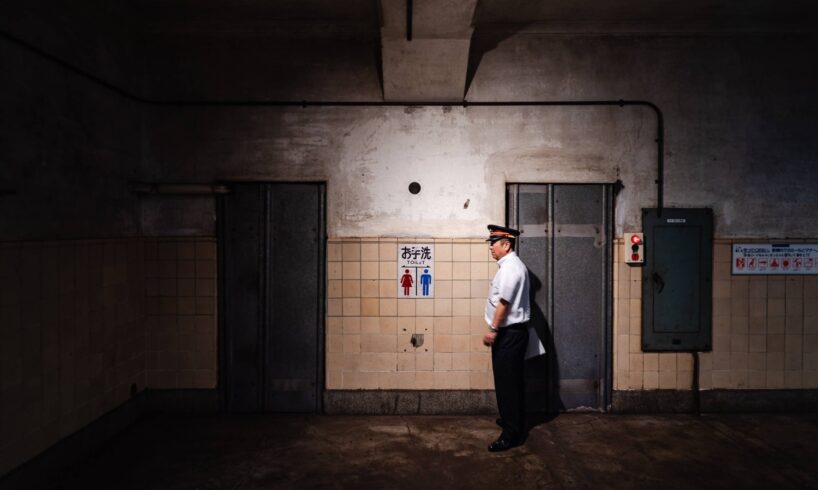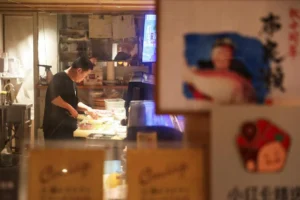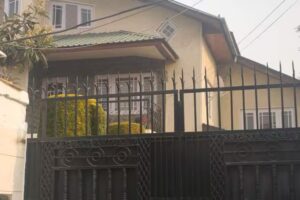
The rumble of the approaching Keisei Skyliner bound for Narita Airport swells into a thunderous roar. The train’s passengers — many of them tourists returning home at the end of their vacations — remain oblivious to us watching them glide by from the dark, soot-stained platform of an abandoned station tucked beneath a corner of Tokyo’s Ueno Park.
A faded poster for Keisei’s high-speed rail hangs on a concrete wall, and an old wooden booth where a clerk once punched paper tickets still stands, its window shuttered and layered with dust. From the station’s opening in 1933 to its suspension in the late 1990s, day-trippers poured through its gates to visit the park’s zoo and museums. Now, these musty traces of railway history and walls scrawled with white chalk graffiti are all that remain.
“Be careful, there’s iron dust, mud and oil everywhere,” says Mamoru Iwai, Keisei Ueno Station’s stationmaster and my guide inside Hakubutsukan-Dobutsuen (Museum-Zoo) Station, a former stop on the Keisei Main Line located halfway between Ueno and Nippori stations.
“If it gets on your clothes, it won’t come off, so try not to brush up against anything,” he says as we explore the underground facility. “They told us to leave everything exactly as it was back then, so yes, it’s still this dirty. But I guess that’s part of the charm, isn’t it?”
It surely is. From the neoclassical station entrance — with its massive emerald-green sliding steel doors, pyramid-like roof and domed ceiling — to the wide concrete staircases leading down to the cool, musty underground platform and tracks, the station exudes a peculiar mix of mystery and urban decay.
Hakubutsukan-Dobutsuen Station, a former stop on the Keisei Main Line, opened in 1933 and operated until service was suspended in 1997. Its ornate entrance features emerald-green sliding steel doors, a pyramid-shaped roof and a domed ceiling.
| JOHAN BROOKS
“I’ve heard that during the war, the site was taken over by the military and used as a factory, or that Japan Railways once kept the emperor’s carriage here,” says Iwai, a veteran of Keisei Electric Railway who has spent decades working his way up from station staff and conductor to train operator and now stationmaster. “I can’t say for certain it’s true, though.”
For railway enthusiasts and ruin hunters alike, these so-called phantom stations that have ceased service offer a glimpse into the city’s past. Hidden from daily view and often closed to the public, they mark moments of transition in the capital’s transit history — from the early years of railway and subway construction to the rapid postwar rebuild. More than curiosities, they stand as weathered industrial records of how Tokyo has expanded, reconfigured and adapted to the demands of a growing metropolis.
“This place hasn’t changed at all since the time the tunnel was first dug,” Iwai says. “It has been reinforced for earthquake resistance, but aside from that, everything’s just as it was back then.”
On imperial land
There’s a story behind Hakubutsukan-Dobutsuen Station’s ornate entrance. When Keisei was working to extend its tracks toward Ueno, the project came with unusually strict conditions: Trains could not run above ground through Ueno Park, the tunnels had to be excavated entirely underground and not a single tree in the park could be damaged.
To complicate matters further, the land where the station is located was categorized as seden goryōchi — an estate handed down through generations of the imperial family. Building anything there required imperial approval, granted only through gozen kaigi, a meeting held in the Emperor’s presence.
Stories abound with regards to the former Hakubutsukan-Dobutsuen Station, with stationmaster Mamoru Iwai saying it was once used for military purposes.
| JOHAN BROOKS
The stakes were high. Only one such meeting would be convened and, if the proposal were denied, there would be no second chance. The company pressed on, and, after much deliberation, it received the emperor’s authorization in March 1932.
“Records from that meeting note that the imperial household insisted the new station ‘must not lack dignity,’ given its location,” says Keisei Electric Railway spokesman Yuichiro Igari as he lays out photocopies of records from the imperial conference stored at the former station. “To meet that standard, the design was entrusted to the architecture division of the then-Ministry of Railways, resulting in the stately, Western-style structure.”
Completed after years of planning and a series of bureaucratic and engineering hurdles — including the challenge of building on a particularly sharp curve — Hakubutsukan-Dobutsuen Station opened as the gateway to the Tokyo Imperial Household Museum (today’s Tokyo National Museum) and nearby Ueno Zoo. It weathered the upheavals of war and shifting fortunes of the postwar decades, serving generations of visitors to Ueno Park. But its compact design eventually sealed its fate: With platforms too short for anything beyond four-car trains and ridership in decline, the station was suspended from service in 1997 and formally closed in 2004.
An old photo of Hakubutsukan-Dobutsuen Station shows a railway employee in a ticket booth at the exit.
| COURTESY OF KEISEI ELECTRIC RAILWAY
Even so, much of its original form has survived. In 2018, the station became the first railway facility designated a historical building by the Tokyo Metropolitan Government for both its architecture and cultural value. Through a collaboration between Keisei and Tokyo University of the Arts, the once-forgotten station has been revived, its green door newly designed by contemporary artist and current university president Katsuhiko Hibino.
“Just recently, the place was used for an event for ‘Frieren: Beyond Journey’s End,’” Igari says, referring to the popular fantasy manga and anime series. “Apparently, the place is reminiscent of the dungeons featured in it.”
The phantom platform
Beneath the constant shuffle of commuters at Tokyo’s Shimbashi Station, a nondescript metal door near Exit 8 of the Ginza Line — Japan’s first subway, opened in 1927 — leads to what’s known as the maboroshi no hōmu, or “phantom platform.”
Inside, the light dims and the air takes on a faint scent of mildew. The space feels heavy with the weight of decades. Built in 1939, the platform stretches about 50 meters. Arched columns line its center, and though most of the original walls are now hidden behind siding panels, through small gaps you can still glimpse the station name “Shimbashi,” spelled right to left in mosaic tiles.
Shimbashi Station’s “phantom platform,” used for just eight months in 1939, remains virtually untouched 86 years later. A glimpse of the station in its heyday, when the station name’s kanji was written right to left.
| JOHAN BROOKS; COURTESY OF TOKYO METRO
Constructed on the eve of World War II, the platform reflects the austerity of its time. Decorative flourishes are minimal, giving the place — closed to the public — a restrained, functional appearance.
The Tokyo Underground Railway — the predecessor to today’s Tokyo Metro — opened Asia’s first subway line between Asakusa and Ueno. In 1934, the line was extended south to Shimbashi Station. Around the same time, another company, Tokyo Rapid Railway, built a separate line from Shibuya to Shimbashi, where the two lines were meant to connect.
“However, there was a disagreement between the two firms,” says Takumi Furusawa, a Tokyo Metro spokesman guiding me on a tour of the hidden platform. The Tokyo Rapid Railway, which had stretched northward from Shibuya, wanted to operate through service between the lines, while the Tokyo Underground Railway, which had snaked southward from Asakusa, instead aimed to extend its route toward Shinagawa. Negotiations dragged on without resolution until the Ministry of Railways stepped in, ultimately approving the long-delayed through service.
“As a result, the Shimbashi Station constructed by Tokyo Rapid Railway was only used for about eight months before it was closed,” Furusawa says, from Jan. 15 to Sept. 15, 1939. “That’s why it came to be known as the ‘phantom Shimbashi Station.’”
A sign in Japanese indicates Shimbashi Station’s “maboroshi no hōmu,” or “phantom platform.”
| JOHAN BROOKS
But research by Tatsuya Edakubo, a former Tokyo Metro employee and railway writer, discovered that wasn’t the only period the station was used.
“When I was working at Tokyo Metro and handling customer relations, an elderly man once came to inquire about the platform’s history,” says Edakubo, author of “The Subway During Wartime: Shimbashi Station’s Phantom Platform and the Teito Rapid Transit Authority.” “He said that, during the war, he had been mobilized to work at a factory and used the Ginza Line for his commute.”
During the Ginza air raids on Jan. 27, 1945, however, a bomb struck directly above the subway route, halting operations for a time. That was the period, the old man claimed, when trains were turning back between Shimbashi and Shibuya using the so-called phantom platform. Curious, Edakubo later checked operational records and Tokyo Metro’s official 50-year history. It seemed to add up: Given the circumstances, the only place where trains could have reversed direction was that long-forgotten platform.
“That platform is a living witness to history,” Edakubo says. “A reminder of another version of the Tokyo subway that might have been.”
Steps through history
Between Kanda and Ochanomizu stations on the Chuo Line, across the street from Akihabara’s electronics district, stands an old vaulted viaduct facing the Kanda River — the only remains of Manseibashi Station, once one of Tokyo’s most impressive landmarks.
Opened in 1912 and named after a nearby bridge, the station was envisioned as a key terminal for both the Chuo and Sobu lines and a symbol of Japan’s rapid modernization. Its designer, Kingo Tatsuno, who would later create Tokyo Station, gave it a striking redbrick, British-inspired design complete with first- and second-class waiting rooms, a restaurant and a bar. Archival records suggest it rivaled Tokyo Station in grandeur.
Across from Akihabara’s electronics district, the red-brick viaduct along the Kanda River is all that remains of Manseibashi Station, once among Tokyo’s grandest landmarks.
| JOHAN BROOKS
The station also flourished as a hub for streetcars, and the surrounding Kanda-Sudacho area developed into one of Tokyo’s most vibrant commercial districts, rivaling even Ginza in its liveliness.
“According to statistics from 1912, the first year of the Taisho Era, Manseibashi Station was already the second busiest stop on the Chuo Line after Shinjuku and ranked fourth within Tokyo overall in terms of average daily passengers,” writes Takaki Nakanishi in his book, “Tokyo’s Phantom Red-brick Stations.”
“Leading the list was Ueno Station with 20,700 passengers per day, followed by Shimbashi, Shinjuku and then Manseibashi. Stations like Yurakucho, Shibuya and Ikebukuro were far lower in rank at the time.”
That glory was short-lived, however. The 1923 Great Kanto Earthquake devastated the area, and Manseibashi’s station building was largely destroyed. Using the surviving foundation, a single-story second station building was constructed in 1925, but the completion of Tokyo Station in 1919 had already shifted the city’s railway focus.
The former Manseibashi Station has been converted into a commercial space with cafes and design shops.
| JOHAN BROOKS
In 1936, the Railway Museum was established adjacent to the station. Manseibashi ceded its main building to the museum, resulting in a much smaller passenger facility. As the war intensified and ridership declined, the station was closed in 1943. Renamed the Transportation Museum five years later, the institution went on to serve generations of railway fans and children for nearly seven decades before ceasing operation in 2006.
“Since then, it had been closed to the public until 2013, when the remains of the station were restored,” says Kazuki Ouchi of the East Japan Railway Culture Foundation. The aging facility was renovated into mAAch ecute Kanda Manseibashi, an artsy commercial space of cafes, design shops and art displays built within the revived infrastructure.
Visitors today can retrace the past along Manseibashi Station’s original platform, reopened as the 2013 Platform. Two preserved stairways lead up through the redbrick viaduct: the 1912 Staircase, built from carved granite at the station’s opening and later used as a special entrance to the adjoining museum, and the 1935 Staircase, added with the museum’s expansion and in use until the station closed in 1943.
“The concept is to preserve as much of the original design as possible,” Ouchi says.
A stairway leads down into Hakbutsukan-Dobutsuen Station in Ueno Park, Tokyo.
| JOHAN BROOKS
The craftsmanship of the masons who built the space more than a century ago still stands out. The landing of the 1912 Staircase was made from concrete, a new material at the time. A small sign explains that the wall tiles feature fukurin meji — rare, traditional Japanese half-round mortar joints that lend the structure a softer, more refined appearance also used in Tokyo Station’s Marunouchi Station Building.
Inside the complex is a meticulously reconstructed diorama of the Manseibashi Station area at its Taisho Era peak, re-created from numerous photographic references. As I look at the model, picturing Manseibashi in its former glory, I recall reading in Nakanishi’s book how its in-station restaurant, Mikado Shokudo, once drew some of Japan’s leading writers and intellectuals — among them Ryunosuke Akutagawa and Junichiro Tanizaki — who gathered there to argue over politics, art and culture late into the night.
A century later, those murmurs have drifted elsewhere, but the trains still pass overhead, their rumble absorbed into the city’s endless hum.





